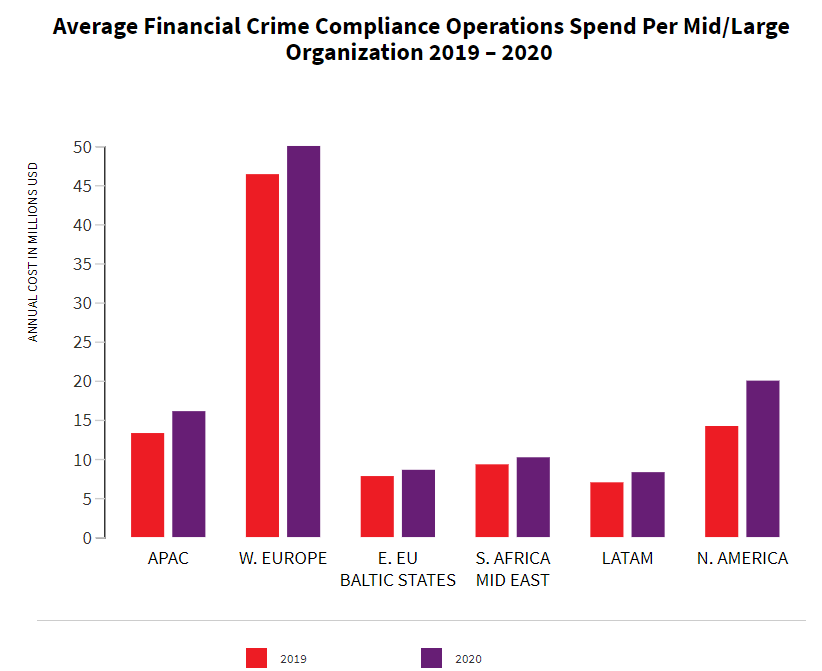LexisNexis Risk Solutions released its annual True Cost of Financial Crime Compliance Global Report. The projected total cost of financial crime compliance across all financial institutions reached $213.9 billion in 2021, surpassing the $180.9 billion recorded in 2020. The majority of this sizeable year-over-year increase is represented by Western Europe and the United States.

Key findings:
- Western Countries Continue to Spend Highest on Compliance – Western European countries and the U.S. continue to represent 82.7% of global total projected costs. Germany and the U.S. bear the bulk of cost increases at $9.6 billion and $8.8 billion respectively with Germany outsizing all other countries by a considerable amount. Mid to large financial institutions lead this growth where all regions, excluding South Africa and the Middle East, show double digit percentage increases in compliance costs.
- Less Consensus on Operational Challenges – In previous years there has been consensus on the top two or three ranked compliance challenges within financial institutions. There is less uniformity in this year’s survey. Customer risk profiling, sanctions screening, regulatory reporting, identifying politically exposed persons (PEPs), KYC for account onboarding and efficient alerts resolution are all similarly ranked as key challenges. Different regions see varying degrees to which certain challenges are more heightened, however.
- Pandemic Impact – The ongoing pandemic has left a significant imprint on compliance departments, which exacerbated existing issues and led to an increase in the time and spending needed for due diligence. Mid and large firms in the U.S. and Canada and parts of LATAM experienced sizeable pandemic-related cost increases. Key operational challenges became heightened in these markets since the start of the pandemic, including increased alert volumes and suspicious transactions, inefficiencies with alert resolution and due diligence, more manual work and limitations with proper risk profiling/sanctions screening/PEP identification.
- Technology Investment Leads to Better Outcomes – Financial institutions implementing technology solutions to support financial crime compliance efforts have been more prepared and less impacted overall by increasing regulatory pressures and COVID-19. Compared to firms that distributed more of their annual compliance costs to labor, those that allocated costs more toward technology are seeing smaller year-on-year financial crime compliance operations cost increases, lower costs per full-time employee and fewer pandemic-related challenges.
Leslie Bailey, vice president, financial crime compliance for LexisNexis Risk Solutions, said in a statement: “Criminals will never cease to become more sophisticated, but a multi-layered solution approach to financial crime compliance can facilitate a more cost-effective, efficient compliance approach, as well as one that benefits the larger organization. Financial institutions should investigate both the physical and digital identity attributes of their customers, leveraging data analytics to assess risks and behaviors in real time.”
He added: “There is now increased recognition among financial institutions that financial crime compliance initiatives provide broader benefits. Utilizing the right technologies as compliance workforces grow allows the team to focus on higher-value, more complex compliance tasks that require skilled human analysis.”
The results derived from the comprehensive survey of 1,015 financial crime compliance decision makers at financial institutions including banks as well as investment, asset management and insurance firms globally. The decision makers who took part in the study oversee financial crime compliance processes such as sanctions monitoring, know your customer (KYC) remediation, anti-money laundering (AML) and transaction monitoring.

